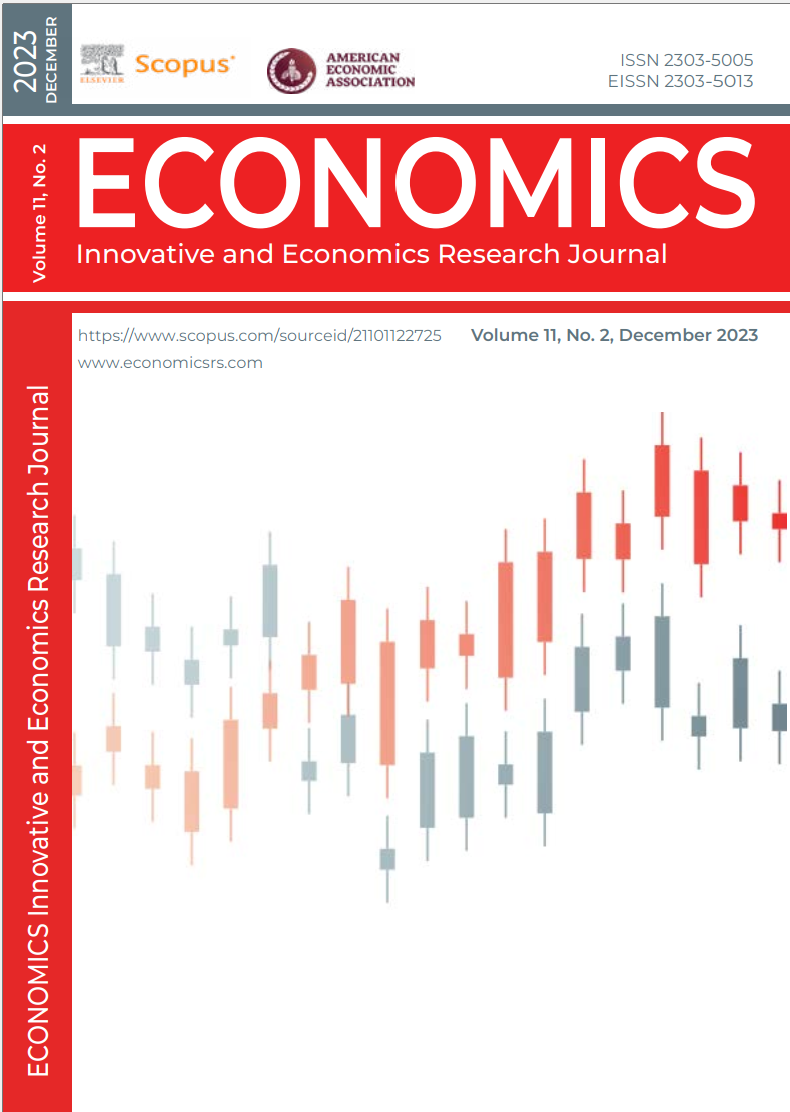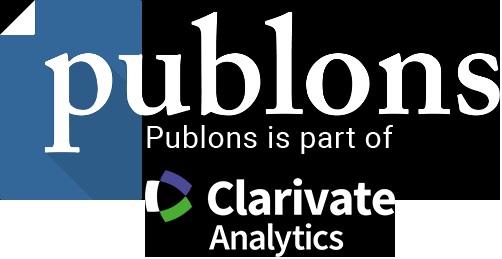THE GEOPOLITICAL “PUZZLE” OF THE CENTRAL BANK’S SWITCH TO GOLD
DOI:
https://doi.org/10.2478/eoik-2023-0018Keywords:
gold, currency reserves, central banks, geopolitical risks, reserve diversification, military expendituresAbstract
Gold holdings increased during recent time. Geopolitical factors could be responsible for such shift taking into account rising number of conflicts in the world since 2014. However, optimal share for gold in external assets is still disputable. The paper provides empirical tests to identify political economy factors of central bank’s gold holdings. The paper imply two empirical approaches: analysis of how gold reserves in tones and as a share of reserves distributed among the countries with different political regimes; logit regression to identify role of political economy factors that may push countries’ switch to gold. Results of empirical analysis shows that political regime itself is not obvious driving force of gold share. Excluding developed countries, it is possible to see that autocracies do not outperform democracies in terms of mean and median share of gold systematically. Countries demonstrated shifts toward gold early then reference point of 2014 year despite political regime. Logit regression also helps to see that countries heavily have being exposing to gold are more likely hoarding large exchange reserves and politically stable. Proxies of geopolitical aggressiveness are valid with some covenants. While Global Peace Index is well proxy to identify geopolitical preconditions of countries’ switch to gold, military expenditures are not. This means that geopolitical motives of gold hoarding probably work directly and indirectly through exchange reserves accumulation and supportive political stability. Geopolitical aggressiveness that coincides with only large military expenditures but not with reserves accumulation is likely to stand on weak economic ground.
References
Abduloev, I., Epstein, G., Gang, I. (2020). A Downside to the Brain Gain Story. ECONOMICS-Innovative and Economics Research Journal, 8(2),9-20. https://doi.org/10.2478/eoik-2020-0017
Agemoglu, D., Yared, P. (2010). Political Limits to Globalization. American Economic Review, 100(2),83-88. https://doi.org/10.1257/aer.100.2.83
Aizenman, J., Inoue, K. (2012). Central Banks and Gold Puzzles. NBER Working Paper, 17894, 1-44. https://www.nber.org/system/files/working_papers/w17894/w17894.pdf
Aizenman, J., Marion, N. (2004). International Reserve Holding with Sovereign Risk and Costly Tax Collection. Economic Journal, 17, 370-400. https://doi.org/10.2139/ssrn.1288138
Arslanalp, S., Eichengreen, B., Simpson-Bell, Ch. (2022).The Stealth Erosion of Dollar Dominance: Active Diversifiers and the Rise of Non traditional Reserve Currencies. IMF Working Paper, WP/22/58, 1-42. https://www.imf.org/en/Publications/WP/Issues/2022/03/24/The-Stealth-Erosion-of-DollarDominance-Active-Diversifiers-and-the-Rise-of-Nontraditional-515150
Arslanalp, S., Eichengreen, B., Simpson-Bell, Ch. (2023). Gold as International Reserves: Barbarius Relic No More? IMF Working Paper, WP/23/14, 1-37. https://www.imf.org/en/Publications/WP/Issues/2023/01/27/Gold-as-International-ReservesA-Barbarous-Relic-No-More-528089
Baur, D. G., & Lucey, B. M. (2010). Is Gold a Hedge or a Safe Haven? An Analysis of Stocks, Bonds and Gold. Financial Review, 45(2), 217-229. https://doi.org/10.1111/j.1540-6288.2010.00244.x
Baur, D., Smiles, L. (2020). Hedging Geopolitical Risks with Precious Metals. Journal of Banking & Finance, 117(C). https://doi.org/10.1016 /j.jbankfin.2020.105823
Baur, D.G., McDermott, T.K. (2010). Is gold a safe haven? International evidence. Journal of Banking & Finance, 34, 1886-1898. https://doi.org/10.1016/j.jbankfin.2009.12.008
Beck, R., Weber, S. (2010). Should Larger reserve Holding Be More Diversified? ECB Working Paper. 1193, 1-48. https://www.ecb.europa.eu/pub/pdf/scpwps/ecbwp1193.pdf
Beckmann, J., Berger, T.,& Czudaj, R. (2015). Does gold act as a hedge or a safe haven for stocks? A smooth transition approach. Economic Modelling, 48(C), 16-24. https://doi.org/10.1016/j.econmod.2014.10.044
Dreher, A., Vaubel, R. (2009). Foreign Exchange Reserves and the Political Business Cycle: A Panel Data Analysis. Journal of International Money and Finance, 28(5), 755-775. https://doi.org/10.1016/j.jimonfin.2008.12.007
Eichengreen, B., Mehl, A., Chitu, L. (2017). Mars or Mercury? The Geopolitics of International Currency Choice. NBER Working Paper, 24145, 1-49. http://www.nber.org/papers/w24145.pdf
Emmrich, O., & McGroarty, F. J. (2013). Should gold be included in institutional investment portfolios? Applied Financial Economics, 23(19), 1553–1565. https://doi.org/10.1080/09603107.2013.839858
Fabris N. (2022). Impact of COVID-19 Pandemic on Financial Innovation, Cashless Society, and Cyber Risk. ECONOMICS- Innovative and Economics Research Journal, 10(1), 73-86. https://doi.org/10.2478/eoik-2022-0002
Fabris, N., Jesic, M. (2023). Are Gold and Bitcoin a Safe Haven for European Indices? Journal of Central Banking Theory and Practice, 12(1), 27-44. https://doi.org/10.2478/jcbtp-2023-0002
Ghosh, A. (2016). Determinants of Gold Demanding Reserve Bank of India’s foreign exchange. Economics Bulletin, 36(4), 1929–1937. http://www.accessecon.com/Pubs/EB/2016/Volume36/EB-16-V36-I4-P188.pdf
Gold Reserves in Central Banks – 2020 Survey Results. (2020). Gold for Central Banking 2020. Central Banking Focus Report, 54-63. https://www.centralbanking.com/gold-for-central-banking-2020 Gopalakrishnan, B.,& Mohapatra, S. (2017). Global risk and demand for gold by central banks. Applied Economics Letters, 25(12),835-839. https://doi.org/10.1080/13504851.2017.1371837
Gürgün, G., Ünalmis, I.(2014). Is gold a safe haven against equity market investment in emerging and developing countries? Finance Research Letters, 11(4), 341-348. https://doi.org/10.1016/j.frl.2014.07.003
Iaccurci G. (2021). Gold as an inflation Hedge? History Suggests Otherwise. https://www.cnbc.com/2021/06/08/gold-as-an-inflation-hedge-history-suggests-otherwise.html
Jager, K. (2016). The Role of Regime Type in the Political Economy of Foreign Reserves Accumulation. European Journal of Political Economy, 44, 79-96. https://doi.org/10.1016/j.ejpoleco.2016.05.001
Joahim K. (2015). Facts and Fantasies about Gold. Published in: Facts and Fantasies about Gold , 1(1), 1-12. https://mpra.ub.uni-muenchen.de/64590/
Koziuk, V. (2021)b. Gold Prices: Does Geopolitical Tensions Really Matter? World of Finance, 2(67), 8-22. https://doi.org/10.35774/sf2021.02.008
Koziuk, V. (2021)c. Role of Gold in Foreign Exchange Reserves of Commodity Exporting Countries. Journal of European Economy, 20 (2), 211-232. https://doi.org/10.35774/jee2021.02.211
Koziuk, V. (2021)а. Does Political Regime Matter for Abnormal Hoarding of International Exchange Reserves? Journal of International Studies, 14 (2), 208-227. https://doi.org/10.14254/2071-8330.2021/14-2/14
Koziuk, V. (2022)a. Drivers of Gold Fraction in Global Exchange Reserves. Journal of European Economy, 21(2),137-153. https://doi.org/10.35774/jee2022.02.137
Koziuk, V. (2022)b. Central Bank’s Reserves: Is Gold a ”safe haven” in case of geopolitical turmoil? Vox Ukraine.
Leblang, D., Pepinsky, Th. (2008). To Have or to Hoard? The Political Economy of International Reserves. Paper Presented at the 2008 Annual Meetings of the American Political Science Association, Boston, M.A. https://courses.cit.cornell.edu/tp253/docs/ToHaveAndToHoard.pdf
Mastilo Z., Bozovic N., Mastilo D. (2021). Central Bank in the Development of the National Economy of the Bosnia and Gercegovina. International Letters of Social and Humanistic Sciences, 90, 26-36. https://www.scipress.com/ILSHS.90.26.pdf
Moghadam Bahrami, S., Bahernia, N. (2021). The political economy of gold in geo-economic evolving conditions. Geopolitics Quarterly, 16(60), 209-233.
http://journal.iag.ir/article_110566_378ad9154515db1feda3fcce6e153ca2.pdf?lang=en
O’Connor, F., Lucey, B., Batten, J., Baur, D. (2015). The Financial Economics of Gold – A Survey. International Review of Financial Analysis, 41, 186-205. https://doi.org/10.1016/j.irfa.2015.07.005
Oktay, B., Öztunç, H., &Serİn, Z. V. (2016). Determinants of Gold Reserves : An Empirical Analysis for G-7 Countries. Procedia Economics and Finance, 38, 8-16. https://doi.org/10.1016/S2212-5671(16)30172-1
Qin, M., Su, Chi.-W., Qi, Xi-Zh., Hao, L.-N. (2020). Should Gold Be Stored in Chaotic Eras? Economic Research, 33 (1), 224-242. https://www.tandfonline.com/doi/full/10.1080/1331677X.2019.1661789
Reboredo, J. (2013)b. Is gold a hedge or safe haven against oil price movements? Resources Policy, 38(2), 130-137. https://doi.org/10.1016/j.resourpol.2013.02.003
Reboredo, J. (2013)а. Is Gold a Safe Haven or a Hedge for the US Dollar? Implications for Risk Management. Journal of Banking and Finance, 37(8), 2665-2676. https://doi.org/10.1016/j.jbankfin.2013.03.020
Son, B. (2020). Democracy and Reserves. Foreign Policy Analysis,16(3), 417-437. https://doi.org/10.1093/fpa/orz020
Sousa Barros, T. (2020). Central Bank’s Gold Reserve: Hedge or Weapon?(No. 152418066) [Doctoral dissertation, Universedada Catolica Portuguese]. Repositório Institucional da Universidade Católica Portuguesa, 1-50. https://repositorio.ucp.pt/bitstream/10400.14/29850/1/152418066_Teresa%20Barros_DPDFA.pdf
Szayna, Th., O’Mahony, A., Kavanagh, J., Watts, S.,Frederick, B., Norlen, T., Voorhies, Ph. (2017). Conflict Trends and Conflict Drivers: An Empirical Assessment of Historical Conflict Patterns and Future Conflict Projections. Rand Corporation. Santa Monica. California, 286. https://doi.org/10.7249/RR1063
Zulaica, O. (2020). What Share for Gold? On the Interaction of Gold and Foreign Exchange Reserve Returns. BIS Working Paper, 906, 1-30. https://www.bis.org/publ/work906.pdf
Downloads
Published
How to Cite
Issue
Section
License

This work is licensed under a Creative Commons Attribution-NonCommercial-NoDerivatives 4.0 International License.























